Showing all 9 resultsSorted by price: high to low
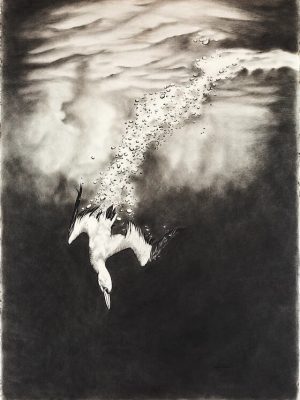
This Limited Edition Print is 60 cm x 80 cm
The Australasian gannet (Morus serrator), also known as Australian gannet and tākapu, is a large seabird of the booby and gannet family, Sulidae. Adults are mostly white, with black flight feathers at the wingtips and lining the trailing edge of the wing. These amazing birds dive from heights of 30 metres, entering the water at speeds of up to 100 km/h.
This is an Archival Print.
Price includes postage within Australia

Print Size: 80cm x 60cm
The king penguin (Aptenodytes patagonicus) is the second largest species of penguin, smaller, but somewhat similar in appearance to the emperor penguin. There are two subspecies: A. p. patagonicus and A. p. halli; patagonicus is found in the South Atlantic and halli in the South Indian Ocean (at the Kerguelen Islands, Crozet Island, Prince Edward Islands and Heard Island and McDonald Islands) and at Macquarie Island.[2]
King penguins mainly eat lantern fish, squid and krill. On foraging trips king penguins repeatedly dive to over 100 meters (300 ft), and have been recorded at depths greater than 300 meters (1,000 ft).[3]
King penguins breed on the sub-antarctic islands at the northern reaches of Antarctica, South Georgia, and other temperate islands of the region.
This is an archival print. To view our limited edition prints click here.
*Price includes postage anywhere within Australia.
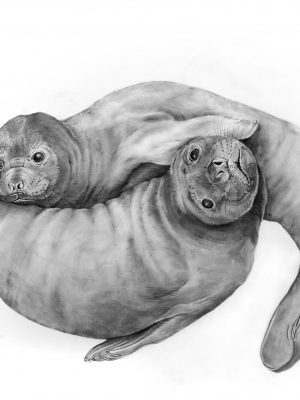
Print Size: 80cm x 60cm
The southern elephant seal (Mirounga leonina) is one of two species of elephant seals. It is the largest member of the clade Pinnipedia and the order Carnivora, as well as the largest extant marine mammal that is not a cetacean. It gets its name from its massive size and the large proboscis of the adult male, which is used to produce very loud roars, especially during the breeding season.
The pups were not twins but obviously made the most of each other's body warmth. Here, they are approximately 2 months old.
This is an Archival Print.
*Price includes postage anywhere within Australia.
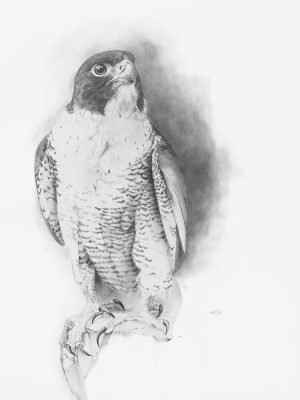
Peregrine falcon (Falco peregrinus)
All confirmed nests in Tasmania have been on cliffs. A site sheltered from heavy rain or high chill-factors is preferred and just a scrape is made to lay eggs.
Tasmania is a great place for peregrines but far from the best. The nesting population recovered from ravages of organochlorine pesticides in the 1960s, 1970s and into the 1980s, through legal protection in the early 1970s to now. With approximately 120 breeding pairs, the population has been relatively stable for some years now. Most are clustered in river valleys and along suitable coastline and on inshore islands and where close (< 4km apart) pairs tend to be evenly distributed due to their territorial nature. Nests are fiercely defended against all kinds of perceived threats and predators.
Size: A2 (59.4 cm x 42 cm). Printed on 310 gsm Museum quality art paper.
This is an archival print.
*Price includes postage anywhere within Australia
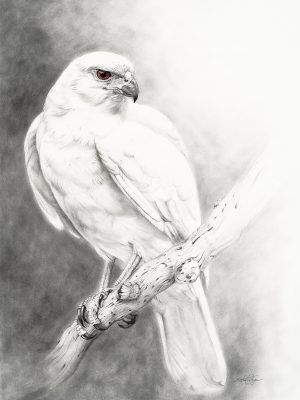
Grey goshawk - white morph (Accipiter novaehollandiae)
The grey morph has a pale grey head and back, dark wingtips, barred grey breast and tail, and white underparts. The white morph is the only bird of prey in the world to be entirely white.
Grey Goshawks are about 40–55 cm long, with wingspans of 70–110 cm. Females are much larger than males, weighing about 680 g. Males average 350 g.
Goshawks usually prey on mammals such as rabbits, possums, and bats. They may also eat birds, small reptiles, and insects. Females, due to their size, can catch larger prey than males.
Hunting is often done by stealth, and very successfully, but Grey Goshawks are willing to pursue their prey before catching it with their talons
Size: A2 (59.4 cm x 42 cm). Printed on 310 gsm Museum quality art paper.
This is an archival print.
*Price includes postage anywhere within Australia
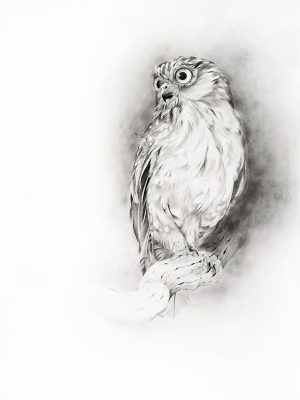
Southern Boobook owl (Ninox novaeseelandiae)
The Southern Boobook is the smallest and most common owl in Australia. It is identified by its plumage, which is dark chocolate-brown above and rufous-brown below, heavily streaked and spotted with white. The facial disc is chocolate brown and the eyes are large and yellowish. Tasmanian birds are smaller and more heavily spotted with white. Young Southern Boobooks are almost entirely buff-white below, with conspicuous dark brown facial discs. Like other owl species, the Southern Boobook is nocturnal.
Size: A2 (59.4 cm x 42 cm). Printed on 310 gsm Museum quality art paper.
This is an archival print.
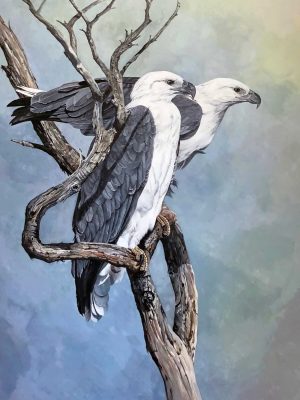
Print Size: 45cm x 30cm (no matt surround)
The white-bellied sea eagle (Haliaeetus leucogaster), also known as the white-breasted sea eagle, is a large diurnal bird of prey in the family Accipitridae. Originally described by Johann Friedrich Gmelin in 1788, it is closely related to Sanford's sea eagle of the Solomon Islands, and the two are considered a superspecies. A distinctive bird, the adult white-bellied sea eagle has a white head, breast, under-wing coverts and tail. The upper parts are grey and the black under-wing flight feathers contrast with the white coverts. The tail is short and wedge-shaped as in all Haliaeetus species. Like many raptors, the female is slightly larger than the male, and can measure up to 90 cm (35 in) long with a wingspan of up to 2.2 m (7.2 ft), and weigh 4.5 kg (9.9 lb).
This is an archival print. To view our limited edition prints click here.
*Price includes postage anywhere within Australia.
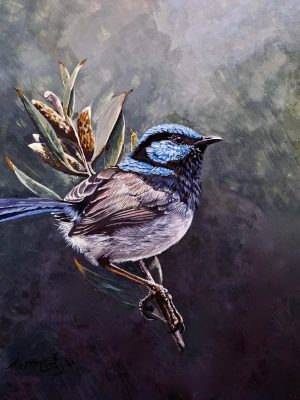
Print Size: 20cm x 20cm (with matt surround)
The superb fairywren (Malurus cyaneus) is a passerine bird in the Australasian wren family, Maluridae, and is common and familiar across south-eastern Australia. The species is sedentary and territorial, also exhibiting a high degree of sexual dimorphism; the male in breeding plumage has a striking bright blue forehead, ear coverts, mantle, and tail, with a black mask and black or dark blue throat. Non-breeding males, females and juveniles are predominantly grey-brown in colour; this gave the early impression that males were polygamous, as all dull-coloured birds were taken for females. Six subspecies groups are recognized: three larger and darker forms from Tasmania, Flinders and King Island respectively, and three smaller and paler forms from mainland Australia and Kangaroo Island.
This is an archival print. To view our limited edition prints click here.
*Price includes postage anywhere within Australia.

Print Size: 25cm x 25cm (with matt surround)
The Southern fairy prion is a member of the Pachyptila genus, and along with the blue petrel makes up the prions. They in turn are members of the Procellariidae family, and the Procellariiformes order. The prions are small and typically eat just zooplankton;[2] however as a member of the Procellariiformes, they share certain identifying features. First, they have nasal passages that attach to the upper bill called naricorns. Although the nostrils on the albatross are on the sides of the bill. The bills of Procellariiformes are also unique in that they are split into between 7 and 9 horny plates. They produce a stomach oil made up of wax esters and triglycerides that is stored in the proventriculus. This is used against predators as well as an energy rich food source for chicks and for the adults during their long flights.[3] Finally, they also have a salt gland that is situated above the nasal passage and helps desalinate their bodies, due to the high amount of ocean water that they imbibe. It excretes a high saline solution from their nose.
This is an archival print.
*Price includes postage anywhere within Australia.
